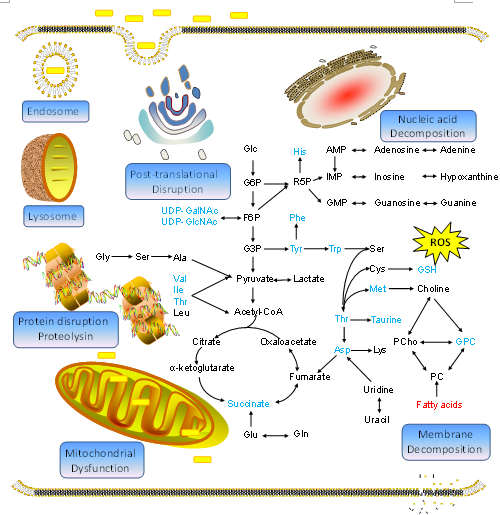Recently, Prof. Yulan Wang's group made new progress in researching into the biological effects of gold nanorods on cell metabolism. The achievements have been published in the peer-reviewed journal Advanced Healthcare Materials. (Adv. Healthcare Mater. 2016, 5, 2363-2375)
Gold nanorods (AuNRs) have shown their great potential in cancer treatment due to their special physiochemical and optical properties, and the ease of surface modification. However, the molecular mechanism of biological effects induced by different surface modified AuNRs remains largely undetermined. These AuNRs are anticipated to interact with various kinds of biological molecules both on the surface and inside of cells. Hence, it is of great importance to know how these AuNRs affect metabolism.
Prof. Wang's group systematically investigated metabolic effects of three different surface modified AuNRs on two different cells, A549 cells and 16HBE cells. A549 cells were derived from human lung adenocarcinoma cells, and 16 HBE cells were derived from normal human bronchial epithelial cells. Three different surface modifications are anionic poly sodium-p-styrene sulfonate (PSS)-AuNRs, cationic poly diallyldimethyl ammonium chloride (PDDAC)-AuNRs and branched poly ethylenimine (PEI)-AuNRs. They found that positively and negatively charged AuNRs induced different metabolic responses. Most importantly, they found that the PEI-AuNRs displayed specific cytotoxicity to A549 cancer cells whilst posing little impact on 16HBE cells. The cytotoxicity of PEI-AuNRs to A549 cells is manifested in large disruptions to the cell metabolisms, which affects energy metabolism, choline metabolism, the hexosamine biosynthesis pathway and oxidative stress to cells. Meanwhile, they found that cationic AuNRs may target choline metabolism of cancer cells. These results provided detailed picture of the metabolic impact of cancer cells exposed to different surface coated AuNRs, and established a relationship between these different coated AuNRs and biological effects they induced. This information would be useful in designing purpose-driven nanomaterials.
The research was supported by grants from the National Basic Research Program of China (2012CB934004) and the National Natural Science Foundation of China .

Schematic diagram of the biological effects of gold nanorods on cell metabolism